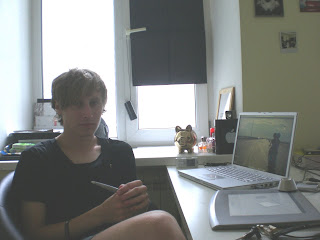“I started taking pictures a couple of years ago with this compact Canon.” – Aleksey takes it from the shelf where several of his cameras are sitting. – “I made my best shots ever with that camera. That is why I still like and use Canon. I can operate it without looking at the buttons. I don’t like Nikon because its interface is so non-intuitive. But Nikon can deliver good pictures though. It is all a matter of habit – which one you use. Plus usually people buy the same brand their friends own, to exchange the lenses.”

“I know some good photographers who would love to switch to Canon from Nikon, but they can’t, because the interface is so much different, and they just can’t learn it.”
“My professional career actually started with this small Canon [in the middle of the picture above]. I went into a club, made a bunch of photos and sold it afterwards to the owners. They thought I made it with a professional camera. That’s how I became a nightclub photographer. In the end I had to drop out of my university after 4 years of study. I realized I won’t be able to juggle both, and I knew the competition is hard among the photographers. I have to work a lot to stay where I am. My mom supported me, so now I am a here, taking pictures for a living.”

“I use Photoshop only for 3 things: adjusting brightness, contrast and cropping. I actually like pictures with bleak lighting, although most photographers reject them. I also shoot my flash straight in the face when I work in a nightclub. Other photographers would come to me and give me advice on how to deflect the flash and all, but I tell them “This is my way. I like it this way.”
“I never read a book on photography. But I read Helmut Newton biography a million times. I used to read it every day for inspiration. He would come up with really crazy ideas and it really is inspiring to read about them.”
“What I care about in photography is perspective and light. I also think some of my best shots were made when I was drunk. When I work in a club I can easily combine communication with people, drinking and photography. I used to look at the pictures in the morning to recollect the events of the night, I couldn’t remember anything, that’s how drunk I would get. Look at this photo. It is my favorite.” – Points at the photo where he and two girls a downing shots simultaneously by the bar stand. “Now I try to stay sober when I work. Actually if I don’t have a camera with me I feel bored in a club.”
“Sometimes a good shot comes up when you aim and wait for the right moment. Sometimes you just fire several shots without looking and the great one is in there.”
“I don’t know how to shoot film though. The biggest problem is that you can’t see the picture until you process the film and scan it. I would love to learn how to shoot film some time.”
We also find out that he is not really inclined to issue a big album of his photography. He says that a novel with no pictures about his life in photography and clubbing would be more appealing to him: “I really think I have some interesting stories to tell.”
In the end he tells us about his trip to St. Petersburg. The nightclub Solyanka that he visits most often for work and pleasure shipped the scooters for him and his friends to St. Petersburg so that they would make a photo trip report. He shows the pictures on the screen of his mac. “I drive my scooter everywhere. This picture was taken with one hand while driving.”

Today he has only 40 rub (about 1 pound) in his pocket. “Not enough to fill the tank of the scooter.” But he still plans to go for a couple of drinks with his friends in Solyanka.
Insights:
- Lens rental / exchange could encourage people buy Nikon even if all friends use Canon.
- You can get great pictures if you apply your heart and vision, even if you never learnt photography.
- Being able to make pictures on the go without looking at the buttons is important for the young and reckless.
- Taking pictures is a way to get involved into different adventures
No comments:
Post a Comment